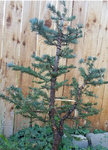amatbrewer
Shohin
I am experimenting with 3 sub alpine firs (Abies lasiocarpa) I have. They were all collected and then field grown for a while (no idea when or for how long) before I got them. They were intended to be landscape trees, but they don’t do well in my clay soil so I figured why not see what I can do with them. All 3 were healthy prior to starting this spring.
I really abused #1, mainly to see how far I could push it…major reduction of roots and branches, repotted in my mostly inorganic bonsai mix (OilDry and a small amount of composted bark) with only a small amount of the original soil, and as some wiring.
#2 received some initial trimming to open it up and shorten some of the lower branches as well as some wiring.
For #3 I just removed dead material and did minimal trimming of any extra-long branches.
#2&3 were overpotted using a sandy mix of soil similar to what they were originally in (and similar to what they naturally grow in) but the roots were left virtually untouched.
All 3 get a mix of sun/shade and regular overhead watering (additional hand watering when necessary). All are receiving an application of organic fertilizer once a month.
I think I was a hairs breath from killing #1 (it is looking rather rough), but it pushed some healthy growth at the branch tips then has done little else since. I plan to give it a year (maybe 3?) to recover. (probably shouldn't be fertilizing it)
The second and third both pushed new growth at the branch tips twice, early spring and again early summer.
#3 is pushing a third batch of needle clusters (see 4th image), mainly from the base of existing branches. I did not measure or wire #3 so can’t really judge how much girth it has put on if any.
#2 is backbudding on branches and trunk (see 5th image). It also grew so much in about 3 months that much of the wire was already cutting deeply and had to be removed (now I have some ugly scars to deal with).
Observations so far:
These might be capable of taking a lot of abuse but they do have their limits.
With the branches and trunks exposed to the sun, healthy material seems capable of backbudding on old and new wood.
Without the branches/trunks exposed to the sun they will branch and produce foliage but may not back bud.
It was my understanding that these may be slow growers (don’t recall where I picked that up) but this does not seem to be the case with a healthy specimen in good conditions.
Something else to monitor: How well does it heal over scars?





I really abused #1, mainly to see how far I could push it…major reduction of roots and branches, repotted in my mostly inorganic bonsai mix (OilDry and a small amount of composted bark) with only a small amount of the original soil, and as some wiring.
#2 received some initial trimming to open it up and shorten some of the lower branches as well as some wiring.
For #3 I just removed dead material and did minimal trimming of any extra-long branches.
#2&3 were overpotted using a sandy mix of soil similar to what they were originally in (and similar to what they naturally grow in) but the roots were left virtually untouched.
All 3 get a mix of sun/shade and regular overhead watering (additional hand watering when necessary). All are receiving an application of organic fertilizer once a month.
I think I was a hairs breath from killing #1 (it is looking rather rough), but it pushed some healthy growth at the branch tips then has done little else since. I plan to give it a year (maybe 3?) to recover. (probably shouldn't be fertilizing it)
The second and third both pushed new growth at the branch tips twice, early spring and again early summer.
#3 is pushing a third batch of needle clusters (see 4th image), mainly from the base of existing branches. I did not measure or wire #3 so can’t really judge how much girth it has put on if any.
#2 is backbudding on branches and trunk (see 5th image). It also grew so much in about 3 months that much of the wire was already cutting deeply and had to be removed (now I have some ugly scars to deal with).
Observations so far:
These might be capable of taking a lot of abuse but they do have their limits.
With the branches and trunks exposed to the sun, healthy material seems capable of backbudding on old and new wood.
Without the branches/trunks exposed to the sun they will branch and produce foliage but may not back bud.
It was my understanding that these may be slow growers (don’t recall where I picked that up) but this does not seem to be the case with a healthy specimen in good conditions.
Something else to monitor: How well does it heal over scars?






